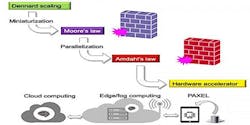Nanophotonic PAXEL could speed up computing, thwarting Moore's Law
A group of researchers from various institutions in Japan has developed a new type of optical processor known as a photonic accelerator (PAXEL), a device that can increase the speed and efficiency of computing and thus potentially provide a way of bypassing Moore's Law in some instances.1 In the technique, a PAXEL is placed at the front end of a digital computer and optimized to perform specific functions but with less power consumption than is needed for fully electronic devices. The researchers hail from the Graduate School for the Creation of New Photonics Industries in Hamamatsu, the National Institute of Information and Communications Technology in Koganei, NTT Basic Research Laboratories in Atsugi, the University of Tokyo, Kyushu University in Fukuoka, and Saitama University.
Metal-oxide semiconductor field-effect transistors are the basis for most integrated electronic circuits, but they are limited by Moore's Law, which says the number of microprocessor chips on a single electronic circuit will double every two years. Due to materials physics, though, there is an inherent limit to Moore's Law, and this limit is quickly being approached. It is possible to partially overcome the Moore's Law problem by using parallel processing, in which multiple processors carry out simultaneous computations. This approach does not work for every application, however.
The researchers looked at a technique to use light for the data-transport step in integrated circuits, since photons are not subject to Moore's Law. Instead of integrated electronic circuits, much new development now involves photonic integrated circuits (PICs). The PAXEL accelerator takes this approach and uses power-efficient nanophotonics, which are ultrasmall PICs.
Analog front end
Nanophotonics operate at the speed of light in the waveguide material and can carry out computations in an analog fashion, with data mapped onto light intensity levels. Multiplications or additions are then performed by varying light intensity. The investigators considered different PAXEL architectures for a variety of uses, including artificial neural networks, reservoir computing, pass-gate logic, decision-making, and compressed sensing.
One particularly interesting application of PAXEL is in so-called fog computing. This is similar to cloud computing but uses computational resources (servers) nearer the "ground" where the originating event occurs. A compact PAXEL attached to a tablet or other hand-held device could detect signals and transmit the information through a 5G wireless link to nearby fog computing resources for data analysis.
Applications of this new technology are expected in a wide array of areas including medical and veterinary point-of-care testing, diagnostics, drug and food testing, and biodefense. As more household and business devices are connected through the web, better computing capacity, including data transport with higher energy efficiency, will be needed. Advances such as PAXEL could help meet these needs.
Source: https://www.eurekalert.org/pub_releases/2019-09/aiop-ult092419.php
REFERENCE:
1. Ken-ichi Kitayama et al., APL Photonics 4, 090901 (2019); https://doi.org/10.1063/1.5108912.
Got optics- and photonics-related news to share with us? Contact John Wallace, Senior Editor, Laser Focus World
Get more like this delivered right to your inbox
About the Author
John Wallace
Senior Technical Editor (1998-2022)
John Wallace was with Laser Focus World for nearly 25 years, retiring in late June 2022. He obtained a bachelor's degree in mechanical engineering and physics at Rutgers University and a master's in optical engineering at the University of Rochester. Before becoming an editor, John worked as an engineer at RCA, Exxon, Eastman Kodak, and GCA Corporation.

